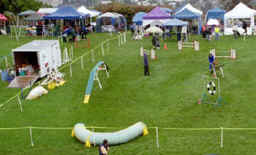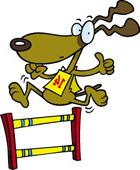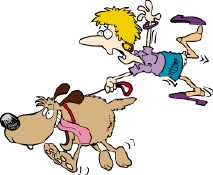|
Dog
Agility Equipment |
 |
|
|
|
|
|
|
Learning Center!
|
Entering a competition Different kinds of events and how to find them  Different kinds of events. Different kinds of events.There are basically two kinds of agility competitions. 1) "Matches" (or "Fun Matches") and 2) Sanctioned trials. Matches are open to mixed breeds and are usually less stringent in rules (i.e. you may be able to use food in the ring and keep your dog on a leash). Matches are cheaper to enter, and some people will purchase more than one "run" with their dog (or dogs) just for the inexpensive practice. Matches may give ribbons or prizes, but qualifications do not add to your dog's "title". To get a "title" on your dog (it's a label, kind of like our educational labels PHD and MD) you must enter a "sanctioned" trial. Sanctioned Trials are put on by more organized dog clubs. They must work under the "sanctioning" of a certain organization, such as AKC (the American Kennel Club), USDAA (United States Dog Agility Association) as well as others such as NADAC. These organizations determine the standards by which the agility trial will be conducted, including the kinds of obstacles used (and the quality) as well as some variation in classes offered, and rules. Some of the organizations require purebreds, some allow mixed breeds (see our link for "Other Resources" for more details on the different organizations and how to find more information on each one). Do not be overly concerned about which organization you will become acquainted with in your first trial. The two largest organizations (AKC and USDAA) have very similar obstacles and classes. What's fun about having different organizations is, you can earn titles in each one. That's double the titles. Imagine how much your dog's puppies will be worth now!
Article feedback: email: training@affordableagility.com My First Trial ....By
Rick Parry
The third trial I attended was the first one I competed in. I arrived that morning at the trial site exhausted. I hadn’t slept the night before because I had been so concerned about the possibility of getting lost on the course myself. I had also been concerned about the weather (late March), concerned about finding the trial location, concerned about checking in and getting the course maps. And I had been very concerned about not getting any sleep! As I had tossed and turned, my dog, Percy, had snored in his bed while lying on his back with his paws flopped over, probably dreaming about food; he kept licking his lips. Clearly, he had been mocking me. Now at the trial, I set up Percy’s crate, and went to check in to get the course maps and my exhibitor’s entry labels to stick on my coat. I studied the Novice Jumpers course for about 10 minutes, and then I heard somebody yell out “Novice Jumpers is open for walk-through.” I thought, “Oh God!” The end was coming near and all my fears were coming true; I was going to have to go into the competition ring. Scared to death I must have walked that course for 20 minutes. I kept thinking about what my instructors had told me: “Watch the more experienced handlers walk the course and try to do what they do.” I was running a fast Cardigan Welsh Corgi. The woman I was following ran Border Collies and was very experienced, so I tried to observe what she was doing. That day the small dogs ran first and Percy was about the fifth dog in the ring. When the gate steward yelled out “Percy’s on deck,” I was terrified. But when she told me, “Go into the ring when the current dog is on jump #10,” I reminded myself that this was only a game and I should just do my best. I relaxed a bit and put Percy in a sit-stay, took a two-jump lead-out, turned, and signaled him to start. He flew over the first three jumps and made the turn very nicely. Then I heard the bar on jump #4 go down. We just continued on the course—and he did the pinwheel nicely—I executed two front crosses, and we didn’t kick any other bars. And I didn’t get lost on the course! Looking back on that run now, it was a great first run and I should have been very proud of that first effort. But during the trial all I could remember was that we kicked a bar and we were eliminated. After the run, it was 8:15 in the morning and I had to wait until 4:30 that afternoon to get back in the ring for Novice Standard. With a lot of time on my hands in a remote location, I talked with my friends about dogs, agility, the weather, the time we were wasting waiting around, and so on. I didn’t understand that I was “wasting” my time out of ignorance. I was trying to relax, but I kept thinking about jump #4. I still think about jump #4 and all the other mistakes I’ve made, but now I try to learn from those mistakes instead of obsessing over them. What I should have been doing between runs was watching all the other dogs running that Jumpers course to see how they handled each challenge. There were some very experienced handlers at the trial that day who were running their new dogs in Novice and I missed them! As I continued trialing, I realized that there are many facets to an agility trial, and running your dog is just one of them. Working as part of the ring crew is another aspect, and I discovered that it provides a real education. My discovery began when I volunteered to work at a trial as a score runner for a Standard course. As I sat there, the timer, the scribe, and the assistant scribe started talking about the teams and their strategies on the course. They discussed how smaller dogs run courses differently than larger dogs, how different teams worked different solutions to course traps, how handlers made mistakes in body position, how the judges positioned themselves to see the contacts, and so on. I could not believe the valuable information I was gaining from experienced handlers just by sitting in the ring listening and walking score sheets over to the score table. At other trials I worked as a leash runner. People standing around the ring steward talked strategy—how to handle a trap, the handler’s position on the lead-out. They said things like, “They’re going to try something wild and exciting,” or, “That team is so fun to watch; it’s as if they’re dancing out there.” It was another educational opportunity, and it was free for the taking. Armed with a little handler experience and pointers for what to look for on the courses, next I sat in the ring setting bars for jumps. It was fun and exciting, and it furthered my education. One day I watched a handler do a blind pinwheel on a Jumpers course and I had a front row seat! Watching people layer obstacles, handling dogs from 20' and even farther away, is inspiring with an up-close perspective sitting in the ring. It can open your eyes to what is possible and provide you with new techniques and strategies to solve some of the toughest course challenges. Looking back at my trialing experience, I realize that I should have spent more time visiting and working at trials before I started competing. This approach would have made me more familiar with the whole trialing process—helping to build courses, working with the ring crews, talking with judges—all the while learning from everybody else’s expertise. Working at a trial is part of the trial experience. It helps the club sponsoring the trial, it supports the sport, and to a Novice handler, it provides an education that has no equal. Actually, a handler at any level can benefit from this interaction. Today I ask those that are new to training in agility to consider taking a couple of hours and visiting a trial. I ask you to actually talk with people around the competition ring, being mindful not to interfere with those preparing to enter the ring or those leaving the ring. Watch the teams run the courses, see what the judges are doing, and talk to those you know and don’t know, and especially to those that compete with the same type of dog you are training. At the first trials I visited I cheated myself by not interacting more with the competitors. I should have asked more questions about how the process works. After visiting a trial or two, consider volunteering to work at a trial before you start competing. Do something that allows you to interact with others working a ring; for example, be a score runner, leash runner, timer, or course builder. While nothing can replace the experience of competing in a trial yourself, you can enhance your preparation for your first competition by taking advantage of other aspects of the trialing process. If I had spent more time visiting and working at trials early on, I may have even been able to get a little sleep that night before my first competition—then again, maybe not. ~ Rick Parry has been training in agility for over five years and has competed in both the AKC and NADAC. He has trained two of his own dogs (both Cardigan Welsh Corgis) and he has been an instructor for more than three years. He has helped students at the puppy, introductory, beginning, intermediate, and competition levels of instruction. Contact him at rnparry@earthlink.net. Making the Most of Your Agility Walk-Through By Mary Mandich The first time through the course, walk the dog’s path and look over the course from your dog’s point of view. Step over the jumps. Okay, you don’t have to walk up the A-frame, but do go to the end and stand at the bottom so you can see what your dog will see. Get down to your dog’s eye level at the tunnel exits and walk out of the weave poles as your dog will come out. As you walk, see what your dog sees. Look for off-courses, traps and refusal planes that you might not notice if you walk the handler’s path. This is the information you need to plot your handling strategy. The second time through the course is when you walk your handler’s path. First, figure out where to place your dog at the start line and where you’ll stand for the opening sequence. Then, proceed through the course, moving quickly past the easy parts so you’ll have time to spend on areas where you need to figure out handling strategies – points where you’ll need a front cross or back cross, or to call your dog around a jump, etc. If there are parts of the course where you find it difficult to figure out what to do, go two or three obstacles ahead and work out where you’ll want you and your dog to be when you get there. Then, work your way back toward the tricky part. Often, what you need to do will become obvious. Walk through a third time and look for long straight lines between a series of obstacles. This is where your dog should pick up speed and gain some time. Adjust your handling strategy so your dog can enter these stretches and take the straight lines. Also, look at the end of each of these fast, straight stretches. This is often where the judge has put a difficult off-course, trap or contact obstacle. Recheck your handling strategy at each of these end points. Will your plan fall apart if your dog has moved well ahead of you? Is there an open invitation to your dog to fly off or miss the contact? If so, now’s the time to rethink how you’ll need to handle your dog in these speed zones! Now go back to the points where you need to be in a particular place to execute a manoeuvre such as a front cross. Memorize a visual cue so you can move accurately through these manoeuvres when you run the course. For front crosses, memorize what the jump stanchion (or tunnel exit, etc.) looks like at the point where you execute your pivot for the cross. You will use this image to find that same point when you’re running the course at top speed. Incidentally, this is one of the most valuable tools I have for handling a course that requires pinpoint timing of front crosses. If you have time, go back and walk the course several more times to practise your handling moves and double-check your memory of the course flow. As you leave the course, remember to check in with the gate steward. This is also a great time to make a mental note of the two or three dogs that will run ahead of you so you’ll know when your turn is coming. Use the time while you wait for your run to practise the course. How can you do this? Find a quiet place, close your eyes, and visualize the start of the course. Now, run through the course and physically practise your handling moves. Forget part of the course? Take another look and fill in your memory blank. Do your mental run-through at least twice so that you commit the course and your handling to memory. Sound weird? Not really. This visualization exercise (sometimes called psychocybernetics or “air handling”) is well known to athletes in many sports where it is considered an essential element of executing a successful performance. Finally, potty and warm up your dog. Head for the start line. Take a deep breath. And go for it! Written and copyrighted by Mary Mandich, who has trained her Welsh Springer Spaniels to multiple performance titles, including the highest awards in agility. |

 How to find them in your area.
How to find them in your area. Before
my first agility competition I decided to briefly visit two trials. I watched
several dogs at the Excellent competition level run the Standard course, talked
to a few friends, and had my dog measured for his jump height. I gained a basic
understanding of the trialing process, but I was completely unaware of what it
really meant to attend a trial. It was only months later that I realized how
much more I could have made of those pre-competition visits. One thing that did
impress me about my visits was that some handlers got confused and lost on the
course.
Before
my first agility competition I decided to briefly visit two trials. I watched
several dogs at the Excellent competition level run the Standard course, talked
to a few friends, and had my dog measured for his jump height. I gained a basic
understanding of the trialing process, but I was completely unaware of what it
really meant to attend a trial. It was only months later that I realized how
much more I could have made of those pre-competition visits. One thing that did
impress me about my visits was that some handlers got confused and lost on the
course. 
